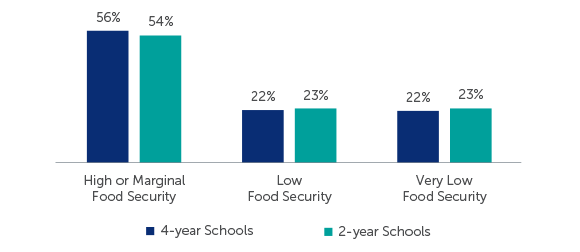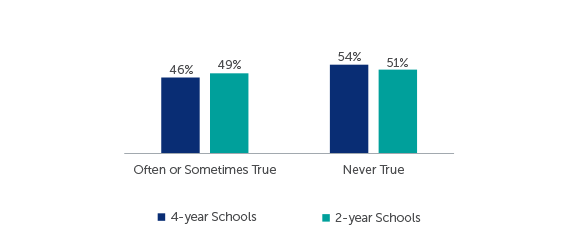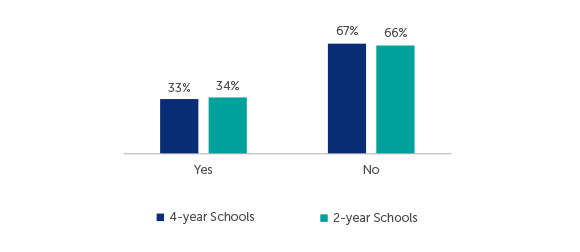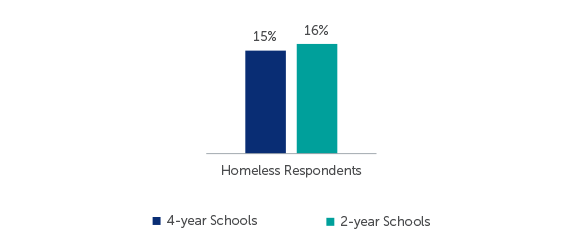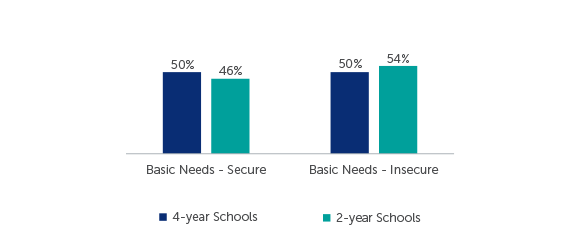THE UNITED STATES DEPARTMENT OF AGRICULTURE (USDA) SHORT-FORM FOOD SECURITY SCALE
This survey uses a short-form, six-question scale designed by the United States Department of Agriculture (USDA) that measures food security within the prior 30 days (from October 2020).
36 The six-question scale has been shown to identify food-insecure individuals and households with high accuracy and minimal bias.
37
- The USDA defines food security as, “access…to enough food for an active, healthy life,” while food insecurity is, “the limited or uncertain availability of nutritionally adequate and safe foods, or limited or uncertain ability to acquire acceptable foods in socially acceptable ways.”38 While food insecurity is not synonymous with hunger, it can be a sign and symptom of food insecurity.39
- USDA methodology assigns levels of food security to individuals based on how many affirmative responses they give to certain questions. Under the short-form survey, individuals who give 2-4 affirmative responses have “low food security” and individuals who give 5-6 affirmative responses have “very low food security”; both are considered “food insecure.” Respondents with 0-1 affirmative responses are characterized as having “high or marginal food security” or food secure.
- Low food security occurs when there are “reports of reduced quality, variety, or desirability of diet, little or no indication of reduced food intake,” while very low food security is characterized as, “reports of multiple indications of disrupted eating patterns and reduced food intake.”40
- While categorical labels are helpful, food insecurity exists on a spectrum, and even the underlying responses to the survey questions cannot definitively locate individuals on that spectrum. Rather, more affirmative responses indicate higher odds that an individual is experiencing greater difficulty maintaining an adequate diet. See Trellis’ “Studying on Empty: A Qualitative Study of Low Food Security Among College Students” for a rich description of collegiate food insecurity.
FOOD SECURITY FINDINGS
Alarmingly, nearly half of respondents at two-year and four-year institutions showed signs of low or very low food security, with little difference observed between the two sectors. (Q89-94)
- At two-year institutions, 46 percent of respondents were classified with either low food security (23 percent) or, more troubling, very low food security (23 percent).
- The prevalence of food insecurity at four-year institutions was strikingly similar to two-year institutions—22 percent of respondents showed signs of low food security and 22 percent indicated very low food security.
- Concerns related to food affordability and sufficiency were common. Nearly half of four-year respondents couldn’t afford to eat balanced meals (46 percent) or ate less than they felt they should (33 percent), compared to 49 and 34 percent of two-year students, respectively.
- Previous studies have not only connected food insecurity to poor health outcomes, including harm to cognitive functions and disease management, but also to students’ mental health, academic performance, and their ability to successfully complete their studies.41 In this survey, respondents with low or very low food security were more likely to report certain demographics and hardships compared to their food secure peers. Higher percentages of these students:
- Reported they would have trouble getting $500 in an emergency
- Indicated worrying about having enough money to pay for their education
- Self-identified as female
- Were first-generation students
UNDERSTANDING THE HOUSING SECURITY AND HOMELESSNESS SCALES IN SFWS
The Student Financial Wellness Survey incorporates standard housing security and homelessness measurements commonly used by other researchers studying basic needs security to ensure data validity, while facilitating comparisons with prior research.
- Housing insecurity is characterized by leading experts in collegiate basic needs as, “a broad set of housing challenges that prevent someone from having a safe, affordable, and consistent place to live.” Homelessness, the most extreme expression of housing insecurity, is often defined as, “a person without a fixed, regular, and adequate place to live.”42
- Respondents are categorized as ‘Housing Insecure’ if they answered “True” to any of the six housing insecurity questions (Q95-100); they are classified as ‘Homeless’ if they answered ‘Yes’ and/or ‘True’ to Q101-110.
HOUSING SECURITY FINDINGS
- Many students struggle to maintain safe, stable housing while in college. This can result in profound impacts on their persistence, and, ultimately, college completion and credential attainment.43
At two-year institutions, nearly half of respondents (48 percent) showed signs of being housing insecure in the prior 12 months, compared with 42 percent of four-year respondents (see previous table).
- Common challenges among respondents included paying the full amount of a gas, oil, or electricity bill (30 percent of two-year students and 22 percent of four-year respondents) and difficulty paying for rent (29 percent of two-year students; 25 percent of respondents at four-year institutions). Only five to six percent of students reported moving three or more times.
HOMELESSNESS FINDINGS
- Homelessness, the most severe form of housing insecurity, is a serious obstacle to students achieving their full academic potential.
While fewer than one in ten respondents in either sector explicitly self-identified as homeless (Q101), 15 percent of four-year respondents and 16 percent of two-year respondents indicated homelessness since starting college or within the 12 months prior to the survey (through their responses to Q101-Q110).
- The most common expression of homelessness occurred when students temporarily stayed with a relative or friend, or couch surfed while looking for housing (11 percent of four-years; 12 percent of respondents at community colleges). Distressingly, four percent of two-year and four-year students, respectively, reported they did not have a home in the past 12 months.
OVERALL BASIC NEEDS INSECURITY (BNI) FINDINGS
College students often experience one or more forms of basic needs insecurity (BNI), whether that be food insecurity, housing insecurity, or homelessness. While there is a high prevalence of basic needs insecurity among college students, generally, certain life circumstances are associated with an even greater risk of experiencing these conditions. This can include being a community college student, identifying as Black, working for pay, having caregiving or parenting responsibilities, or being a first-generation student.44
- At two-year institutions, 54 percent of respondents experienced food insecurity, housing insecurity, or homelessness. This was slightly lower at four-year institutions, where 50 percent faced one or more basic needs insecurities.
- Previous research has documented that students with low or very low food security are at much higher risk of facing housing insecurity.45 In this survey, 29 percent of community college students, and nearly a quarter of four-year respondents, were food insecure and housing insecure.
- Overall, nine percent of students (nine percent of two-year students, and eight percent of four-year respondents) indicated facing food insecurity, housing insecurity, and homelessness within the past year.
- Certain students are more likely to experience basic needs insecurities than others.
- In this survey, respondents with overall basic needs insecurities were more likely to report certain life circumstances, including:
- Working one or more part- or full-time jobs
- Being a first-generation student
- Identifying as female
- Supporting children or other dependents
- Experiencing elevated stress, anxiety, or depression during the pandemic
A high percentage of students are pursuing their degrees while facing basic needs insecurities that make it difficult for them to realize their full academic potential. Institutions must make quick interventions if they are to keep these students in school.

